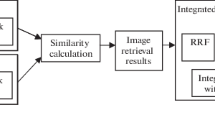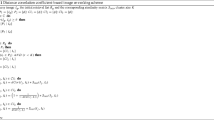Abstract
Content based image retrieval (CBIR) systems could provide more precise results by taking the user’s feedbacks into account. Two types of the relevance feedback learning paradigms are short term learning (STL) and long term learning (LTL). By using both STL and LTL, a collaborative CBIR system is proposed in this paper. The proposed system introduced three fusion methods: including fusion in retrieved images, fusion in ranks, and fusion in similarities to make cooperation between STL and LTL. The proposed fusion methods are examined in a CBIR system equipped with a proposed statistical semantic clustering (SSC) method of LTL. The SSC method works based on the concept of semantic categories of the images by clustering techniques and constructing a relevancy matrix between images and semantic categories. The results of the SSC method with the suggested fusion methods are compared with two state-of-the-art LTL methods, namely virtual feature based method and dynamic semantic clustering. Comparative results confirm the efficiency of the proposed method. Furthermore, experimental results demonstrate that for a unique LTL method, various fusion methods lead to different results.














Similar content being viewed by others
References
Antani S, Kasturi R, Jain R (2002) A survey on the use of pattern recognition methods for abstraction, indexing and retrieval of images and video. Pattern Recognition 35:945–965
Barrett S (2007) Content-based image retrieval: a short term and long-term learning approach, http://digital.cs.usu.edu/~xqi/Teaching/REU07/Website/Samuel/SamFinalPaper.pdf
Barrett S, Chang R, Qi X (2009) A fuzzy combined learning approach to content-based image retrieval. International Conference on Multimedia and Expo, ICME(838–841)
Bhanu B, Dong A (2002) Concept learning with fuzzy clustering and relevance feedback. Engineering Application of Artificial Intelligence 15:123–138
Bulo SR, Rabbi M, Pelillo M (2011) Content-based image retrieval with relevance feedback using random walks. Pattern Recognition 44:2109–2122
Chang SF, Sikora T, Puri A (2001) Overview of the MPEG-7 standard. IEEE Transactions on Circuits and Systems for Video Technology 11(6):688–695
Cheng PC, Chien BC, Ke HR, Yang WP (2008) A two-level relevance feedback mechanism for image retrieval. Expert Systems with Applications 34:2193–2200
Datta R, Joshi D, Li J, Wang J (2008) Image retrieval: ideas, influences, and trends of the new age. ACM Computing Surveys (CSUR) 40(2):1–60
Deselaers T, Paredes R, Vidal E, Ney H (2008) Learning weighted distances for relevance feedback in image retrieval, 19th International Conference on Pattern Recognition (ICPR)
Everingham M, Van Gool L, Williams CKI, Winn J, Zisserman A (2012) The PASCAL visual object classes challenge 2012 (VOC2012) Results. http://www.pascal-network.org/challenges/VOC/voc2012/workshop/index.html
Ferreira CD, Santos JA, Torres RS, Goncalves MA, Rezende RC, Fan W (2011) Relevance feedback based on genetic programming for image retrieval. Pattern Recognition Letters 32:27–37
Han J, Ngan KN, Li M, Zhang HJ (2005) A memory learning framework for effective image retrieval. IEEE Trans Image Process 14(4):511–524
He X, King O, Ma WY, Li M, Zhang HJ (2003) Learning a semantic space from user’s relevance feedback for image retrieval. IEEE Transactions on Circuits and Systems for Video Technology 13(1):39–48
Hoi SCH, Liu W, Chang SF (2010) Semi-supervised distance metric learning for collaborative image retrieval and clustering. ACM Transactions on Multimedia Computing, Communications and Applications 6(3):1–26
Hoi S, Lyu M, Jin R (2006) A unified log-based relevance feedback scheme for image retrieval. IEEE Trans Knowl Data Eng 18(4):509–524
Jing L, Allinson NM (2013) Relevance feedback in content-based image retrieval: A survey. Handbook on neural information processing. Springer, Berlin, pp 433–469
Kim DH, Chung CW, Barnard K (2005) Relevance feedback using adaptive clustering for image similarity retrieval. The Journal of Systems and Software 78:9–23
Lew MS, Sebe N, Djeraba C, Jain R (2006) Content-based multimedia information retrieval: state of the art and challenges. ACM Trans Multimedia Comput Commun Appl 2(1):1–19
Liu Y, Zhang D, Lu G, Ma WY (2007) A survey of content-based image retrieval with high-level semantics. Pattern Recognition 40:262–282
Lu Y, Zhang H, Wenyin L, Hu C (2003) Joint semantics and feature based image retrieval using relevance feedback. IEEE Transaction on Multimedia 5(3):339–347
Ma H, Zhu J, Lyu MRT, King I (2010) Bridging the semantic gap between image contents and tags. IEEE Transactions on Multimedia 12(5):462–473
Nezamabadi-pour H, Kabir E (2009) Concept learning by fuzzy k-NN classification and relevance feedback for efficient image retrieval. Expert Systems with Applications 36:5948–5954
Porkaew K, Chakrabarti K, Mehrotra S (1999) Query refinement for multimedia similarity retrieval in MARS. Proceedings of the ACM International, Multimedia Conference pp. 235–238
Qi X, Barrett S, Chang R (2011) A noise-resilient collaborative learning approach to content-based image retrieval. Int J Intell Syst 26:1153–1175
Rashedi E (2013 ) Content based image retrieval using joint short term learning and long term learning in semantic space, Ph.D Thesis, Shahid Bahonar university of Kerman, 2013 (In Persian)
Rashedi E, Nezamabadi-pour H (2012) A long term learning method in CBIR systems by defining semantic templates. 20th international conference on electrical engineering, University of Tehran
Rashedi E, Nezamabadi-pour H, Saryazdi S (2013) A simultaneous feature adaptation and feature selection method for content-based image retrieval systems. Knowledge-Based Systems 39:85–94
Rashedi E, Nezamabadi-pour H, Srayazdi S (2012) A gradient descent based similarity refinement method for CBIR systems, in the Proceedings of Sixth International Symposium on Telecommunications (IST2012). Tehran, Iran
Rocchio JJ (1971) Relevance feedback in information retrieval. In: Salton G (ed) The SMART retrieval system: Experiments in automatic document processing. Prentice Hall pp. 313–323
Rui Y, Huang S, Ortega M, Mehrotra S (1998) Relevance feedback: a power tool for interactive content-based image retrieval. IEEE Transactions on Circuits and Video Technology 8(5):25–36
Salvador S, Chan P (2003) Determining the number of clusters/segments in hierarchical clustering/segmentation algorithms, Technical Report CS-2003-18, Florida Institute of Technology
Shamsi A, Nezamabadi-pour H, Saryazdi S (2013) A short-term learning approach based on similarity refinement in content-based image retrieval. Multimedia Tools and Applications
Sikora T (2001) The MPEG-7 visual standard for content description-an overview. IEEE Transactions on Circuits and Systems for Video Technology 11(6):696–702
Smeulders AWM, Worring M, Santini S, Gupta A, Jain R (2000) Content-based image retrieval at the end of the early years. IEEE Transactions on Pattern Analysis and Machine Intelligence 22:1349–1379
Su JH, Huang WJ, Yu PS, Tseng VS (2011) Efficient relevance feedback for content-based image retrieval by mining user navigation patterns. IEEE Trans Knowl Data Eng 23(3):360–372
Yin PY, Bhanu B, Chang KC, Dong A (2005) Integrating relevance feedback techniques for image retrieval using reinforcement learning. IEEE Transaction on Pattern Analysis and Machine Intelligence 27(10):1536–1551
Yin PY, Bhanu B, Chang KC, Dong A (2008) Long-term cross-session relevance feedback using virtual features. IEEE Trans Knowl Data Eng 20(3):352–368
Author information
Authors and Affiliations
Corresponding author
Rights and permissions
About this article
Cite this article
Rashedi, E., Nezamabadi-pour, H. & Saryazdi, S. Information fusion between short term learning and long term learning in content based image retrieval systems. Multimed Tools Appl 74, 3799–3822 (2015). https://doi.org/10.1007/s11042-013-1800-6
Published:
Issue Date:
DOI: https://doi.org/10.1007/s11042-013-1800-6




